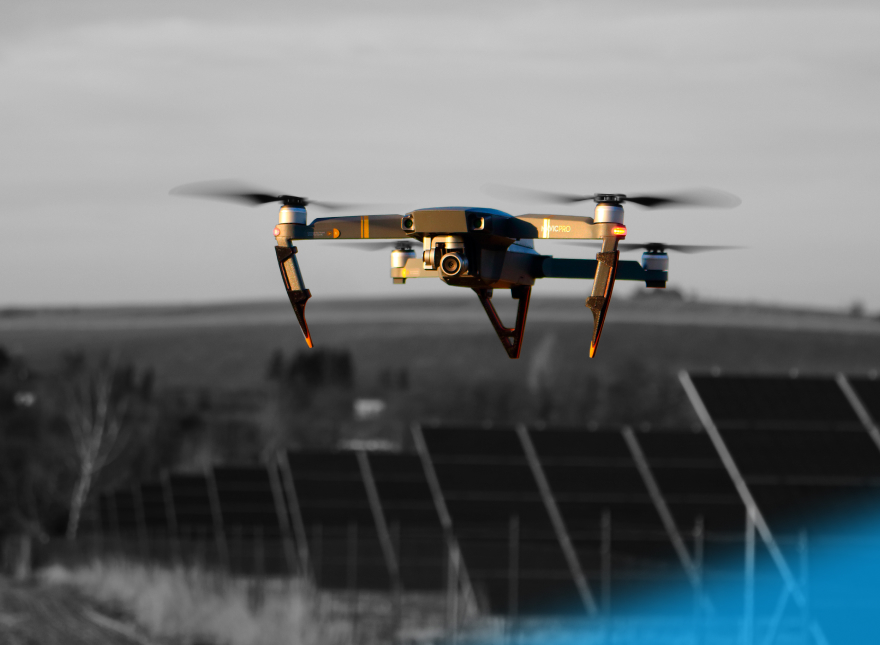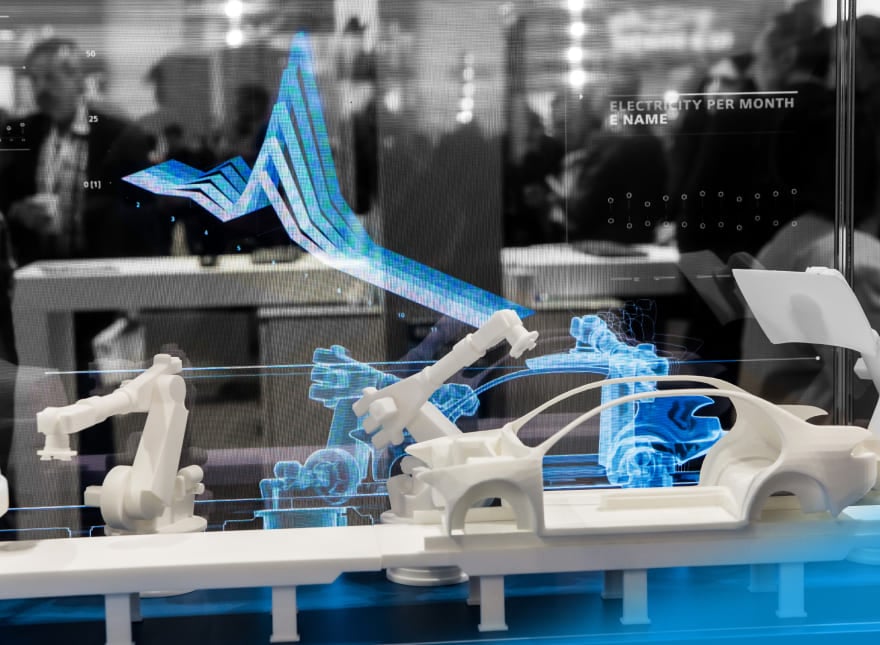Check out our latest blog article: From component to enterprise – modular robotics done right.
How to Enable Reliable Communication between IoT Devices

In IoT systems with multiple sensor devices, it is important to choose the right method of wireless communication. This will help avoid unforeseen costs or loss of critical data. In this article, we will take a look at two common approaches of organizing IoT devices into wireless networks—when you should use them, and what problems you may encounter.
Architecture of a Data Collection System
Be it automatic equipment failure detection systems implemented at factories, a smart lighting management system, or an IoT climate control solution—data collection systems typically include a large number of sensor devices (sensor nodes) that collect information about the environment and send it to a central hub (gateway). The gateway transmits the data to cloud systems for processing and analysis. After that, users can access visualized data via web or mobile interfaces and control the system remotely.
-png.png) A typical data collection process in IoT systems.
A typical data collection process in IoT systems.
In order for sensor devices to transmit captured data for further analysis, they need to be organized into a network. There are two main ways to do this.
Traditional Approach: Star Networks
In a star network, all sensor devices are connected with a gateway, which serves as a common connection point. All data captured by the sensing devices can only be received and sent through the gateway.
Organizing IoT devices into star networks is a fairly simple and cost-effective approach, as signals are only trans mitting back and forth between two points. Another potential advantage is energy savings as star nodes don’t need to be constantly “awake” and can rest between message transmissions, preventing battery drain.
However, star networks have some disadvantages:
- Limited coverage. In a star network, signals can be only transmitted directly from nodes to the gateway. Therefore, the transmission distance is limited by the transmission capacity of the sensor device. To overcome this obstacle, you will have to add new gateways to expand the network.
- Black spots. Any obstacle preventing a sensor node from accessing the gateway (weather, concrete walls, level drops, etc.) can affect the nodes' ability to remain connected to the network, and therefore affect the reliability of the network itself. For this reason, star networks are not always suitable for use in urban areas.
- Gateway connectivity issues. The reliability of star networks totally depends on a properly functioning gateway. If the gateway loses connectivity, the network will not be able to store data. Data loss can be especially critical in industrial equipment inspection and cold chain management.
- Increased energy consumption at great distances between nodes and the gateway. If a sensor node is located far away from the gateway, the signal transmission will increase power consumption.
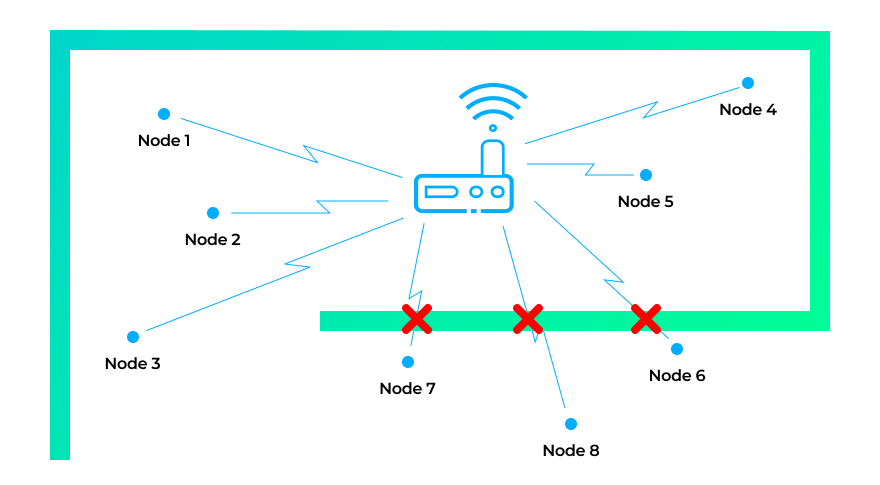
In star networks, nodes can lose connectivity due to physical obstacles and environmental conditions.
More Reliable Approach: Mesh Networks
In a mesh network, all sensor devices cooperate to distribute data in a network of nodes. They not only transmit their own signals, but serve as a repeater, transmitting data from neighboring nodes.
According to Global Market Insights, the size of the wireless mesh market will grow by more than 15% between 2020 and 2026. There are a number of reasons for this:
- Greater coverage area. Unlike star networks, mesh networks are not limited by the coverage radius of individual sensor devices. Nodes will receive signals from neighbouring devices until data reaches the destination point.
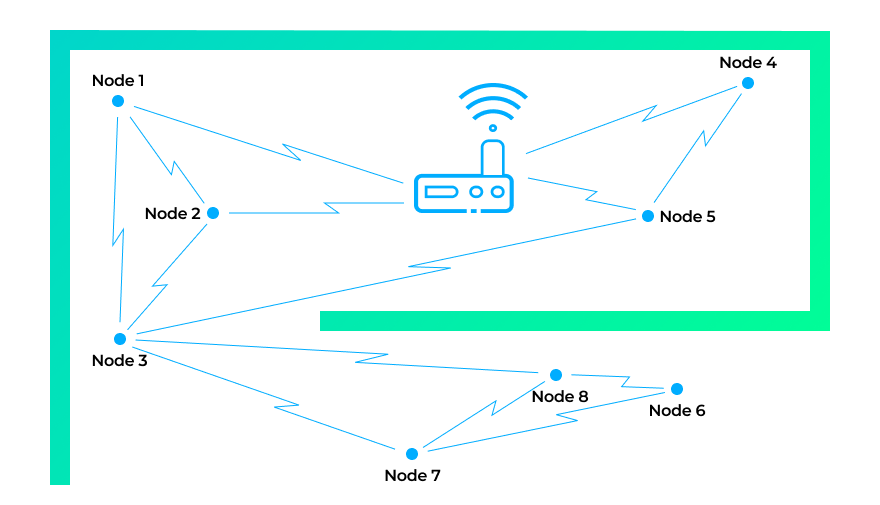
Mesh networks help avoid “black spots” enabling greater coverage and reliable data transmission.
- Easier expansion. To extend the coverage area, you can easily add new devices to the network. There is no need to add new gateways or move existing ones. It is only necessary for a new device to be within reach of a neighboring device. New devices will be automatically incorporated into the existing network without any prior configuration. This makes mesh networks highly flexible and adaptable.
- High reliability. When a new sensor device is added to the network, it automatically checks for available routes to find multiple reliable connections. As a result, the network never relies on a single node, which reduces the risk of a connection failure.
- Self-healing. Mesh networks use self-healing algorithms such as Shortest Path Bridging. If a node loses connection, the algorithm will have it automatically find the shortest path available for data transfer and recover the system without data loss.
Despite the many advantages, there are several factors you should consider before implementing a mesh networking infrastructure:
- High complexity. Mesh networks are more complex in development than star networks because of the complexity of communication protocols and security level implementation, as well as the self-organizing nature of these networks. Moreover, the larger the area that needs to be covered, the more nodes are required. In some cases, it is necessary to install additional nodes, which do not collect data but help extend the network coverage. Having an excessive number of connections significantly complicates network management and maintenance.
- Higher power consumption. Mesh nodes must be constantly in "awake" or "listen" mode, waiting for a signal to be transmitted at any time. This causes higher battery drains than star nodes, especially in devices that often transmit signals.
- Limited transmission capacity. Mesh networks only perform well when transmitting small data packages. For sending large files like videos, a star network would be a better option.
- Complex security implementation. In a sensor network, a single malfunctioning repeater can cause the collapse of the entire system. When it comes to large mesh networks, where all nodes serve as repeaters, the risk of such attacks is highly increased. Thus, when developing mesh networks, it is critical to implement a strong security system. However, increased security usually causes a decrease in network bandwidth. Therefore, in some cases, it is better to use star networks, where security mechanisms are easier to implement.
- Greater latency. Each new node in a mesh network can increase the delay between sending and receiving information. This can be critical for some systems that need to send data packets every few minutes.
Real-life Systems with an IoT Mesh Networking Architecture
Mesh networking architecture is useful for systems designed to collect data from large areas, overcome obstacles in urban environments, and provide reliable data transfer. Here are some examples of how mesh networks can be applied.
- Industrial manufacturing. Linear Technology, a manufacturer of high performance analog integrated circuits, uses mesh networks to streamline their manufacturing operations. They enhance gas cylinders with sensor nodes to track gas levels with >99.999% data reliability. The solution includes control software that automatically logs captured data and visualizes it in real time. By analyzing gas consumption rates, technical specialists can quickly predict gas usage in order to schedule gas refills and ensure an uninterrupted supply.
- Healthcare. A Dutch children’s hospital implemented an IoT mesh network to track their assets like beds, incubators, infusion pumps, and other items to easily find them on the hospital premises. The solution enables inventory control to alert hospital management when supplies are too high or too low and need to be replenished. The hospital also uses a mesh-based smart lightning system. It enables daylight compensation as well as smart grouping and lighting plans based on presence or personal preferences. Enhanced with beacons, the system also supports indoor-navigation on a mobile phone.
- Environmental monitoring. Experts from Johns Hopkins University are using mesh networks to analyze soil microclimates. The team deployed over 100 nodes in a variety of locations around the state of Maryland. The data allowed them to correlate collected soil moisture information with observations of soil organisms to better predict how human activities affect soil. Another example is an air monitoring system proposed by the Universitу Sains Malaysia. The solution includes a network of O2 and temperature sensors and performs oxygen concentration analysis in real time.
What to Consider when Implementing a Wireless Sensor Network
A Future-proof Approach—Planning for New Use Cases
Building an IoT network often involves significant investments. So, it is important to make sure your architecture is extensible and reliable for use cases you can’t imagine today.
Example: street lights. The first generation street light control platforms were designed to turn the lights on and off and retrieve daily status updates. The second generation systems were able to deliver data about energy consumption. Today, street lights are an integral part of Smart City projects, comprising streetlights and proximity sensors to optimize light levels, public safety, and traffic flow. The first generation infrastructure is unable to support the increasing number of sensors needed for new use cases. Therefore, thinking ahead when deploying a networking infrastructure will save companies a lot of money in the future.
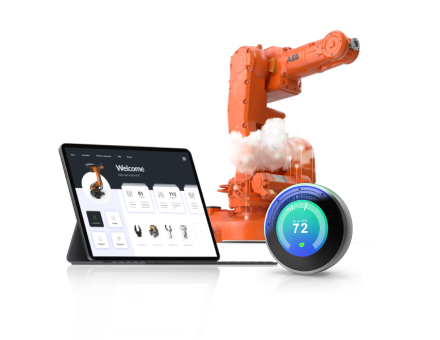
Integrated Approach—Software, Hardware, Connectivity
If you’re looking to integrate a wireless network into your IoT infrastructure, you must examine not just a singular component, but also the whole IoT system—devices, sensors, embedded software, cloud infrastructure, web, and mobile applications. Sometimes it is difficult to predict how these components will interact, how they will exchange data, and how they will interact with your existing IT infrastructure.
If you’re working on an IoT solution and need expert advice, Softeq will help you find the best-suited connectivity option. We’ll help you create a solution with stable performance and maximized battery life. Learn more about our IoT development services.
More articles on the topic

